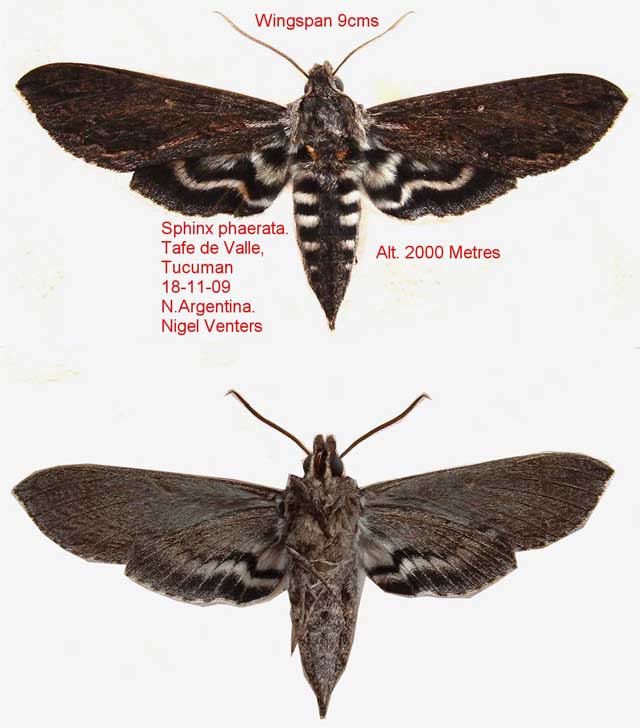|
|
Updated as per
AN ANNOTATED CHECKLIST OF THE SPHINGIDAE OF BOLIVIA, October 2007
Updated as per More, Kitching and Cocucci's Hawkmoths of Argentina 2005, October, 2007
Updated as per personal communication with Fernando Penco, May 2008; very questionable id??, specimen moved to L. maura page
Updated as per The Hawk Moths of the North America, 2007, James P. Tuttle (Sphinx to Lintneria); April 2009
Updated as per CATE; April 2009
Updated as per personal communication with Ezequiel Bustos (Shilap revta. lepid. 43 (172) diciembre, 2015, 615-631 eISSN 2340-4078 ISSN 0300-5267), January 4, 2016
|
Lintneria phalerata
(Kernbach, 1955) Sphinx

Lintneria phalerata Tafe de Valle, Tucuman, Argentina,
November 18, 2009, 2000m, courtesy of Nigel Venters,
traditional wing span probably less than stated.
This site has been created by
Bill Oehlke at oehlkew@islandtelecom.com
Comments, suggestions and/or additional information are welcomed by Bill.
TAXONOMY:
Family: Sphingidae, Latreille, 1802
Subfamily: Sphinginae, Latreille, 1802
Tribe: Sphingini, Latreille, 1802
Genus: Lintneria Butler, 1876 ...........
Species: phalerata Kernbach, 1955
|
MIDI MUSIC
.....It's a Wonderful World.....
copyright C. Odenkirk
ON.OFF
<bgsound src="world.mid" LOOP=FOREVER>
|
DISTRIBUTION:
Lintneria phalerata
(forewing length: 40-45mm) flies in
Argentina: Jujuy, Tucuman: Cochuna and Tafe de Valle (NV); Salta and San Juan, and
Bolivia: Chuquisaca: Tomina (2000m, February).
In his The Hawk Moths of North America, 2007, James P. Tuttle has assigned all the
Sphinx genus species from Mexico south throughout South American to Lintneria, Butler, 1876, based on
consistent differences in wing characters and significant larval differences.
"Forewing length similar to that of Lintneria maura, shorter than in Lintneria aurigutta (about 55 mm.)
"Body upperside differs from Lintneria maura as follows: tegulae darker than the rest of the thorax; external edge of both tegulae dark, starting at the antennae and
continuing on the head and thorax as in Lintneria aurigutta and Lintneria justiciae; inner edges of tegulae are not as strongly defined. In neither
Lintneria arthuri nor Lintneria maura are the tegulae coloured differently from the thorax. Metanotum with 2 golden yellow spots between the two dark
lateral marks. Abdomen upperside similar to Lintneria maura; the underside more similar to Lintneria aurigutta.
Upperside of both wings brownish; pattern similar to Lintneria aurigutta and Lintneria justiciae. Forewing upperside a longitudinal reddish-brown
patch around vein CuA2.
"Hindwing upperside with bands darker than the forewing ground colour, more similar to that of Lintneria maura." CATE
Regarding the image formerly at the top of the page, Nigel Venters writes, "Here is Lintneria phalerata (now at top of page).
Having looked at the images of L. phalerata on your Sphinx moth website, I think the image is of a Lintneria maura! (formerly at top of page)
S. phalerata is much darker, with few markings on the forewings,
and has two small white spots on the forewings. The underside is the clinch as S. maura has a
black line of dots in the sub-marginal area of the forewings. L. phalerata has white body spots reaching further down the body than L. maura."
Ezekiel Bustos also feels pretty certain that the image formerly at top of page is L. maura, and I (Bill Oehlke) agree, and I have moved it to the
L. maura page.
FLIGHT TIMES:
Lintneria phalerata adults fly in January-February-March and November and possibly at other times.
ECLOSION:
Pupae probably wiggle to surface from subterranean chambers just prior to eclosion.
SCENTING AND MATING:
Females call in the males with a pheromone released from a gland at the tip of the
abdomen. Adults probably nectar at a variety of flowers.
EGGS, LARVAE, PUPAE:
Please visit my special request for images of Lintneria species larvae at
Lintneria larvae, and help if you can.
It is anticipated that the Lintneria larvae will most often be encountered on Lamiaceae: Salvia (Sage), Mentha (Mints), Monarda (Beebalm) and
Hyptis (Bushmints); Verbenaceae: Verbena and Lantana camara (shrub verbenas or lantanas).
Although they may be encountered feeding during daylight hours, one is even more likely to discover them feeding in the evening or after dark.
Two of the greatest clues for discovering larvae are stripped foliage and droppings beneath the plant. You might be quite surprised at what will turn up in the evening or
after dark in a flashlight assisted search.
It is believed that all "Lintneria larvae will exhibit "a fleshy thoracic dorsal "horn" in the first 4 instars (unique in the Sphingidae of the world to my
knowledge) which is replaced by a thoracic dorsal "hump" with a large black patch in the 5th instar." J.A. Tuttle.
Use your browser "Back" button to return to the previous page.
Return to Sphingidae Index
Return to Sphingini Tribe
Use your browser "Back" button to return to the previous page.
This page is brought to you by
Bill Oehlke and the
WLSS. Pages are on space rented from Bizland. If you would like
to become a "Patron of the Sphingidae Site", contact Bill.
Please send sightings/images to Bill. I will do my best to respond to requests for identification help.
Enjoy one of nature's wonderments: Live
Saturniidae (Giant Silkmoth) cocoons.
 | 
Show appreciation for this site by clicking on flashing butterfly to the left.
The link will take you to a page with links to many insect sites. |


